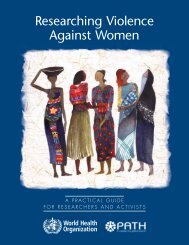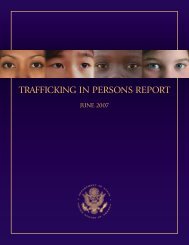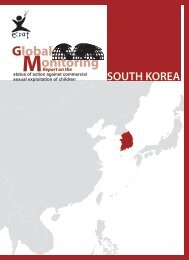Download PDF - Violence Against Children - East Asia and the ...
Download PDF - Violence Against Children - East Asia and the ...
Download PDF - Violence Against Children - East Asia and the ...
Create successful ePaper yourself
Turn your PDF publications into a flip-book with our unique Google optimized e-Paper software.
introduction<br />
To follow up <strong>the</strong> CAN study, World Vision<br />
has reviewed approaches to protecting<br />
children at risk in five <strong>Asia</strong>n countries, <strong>and</strong><br />
conducted fur<strong>the</strong>r analysis to enable <strong>the</strong><br />
agency to determine what are effective<br />
programs <strong>and</strong> policies for preventing <strong>and</strong><br />
addressing this abuse <strong>and</strong> neglect.<br />
The research is framed by <strong>the</strong> principles<br />
expressed in <strong>the</strong> United Nations Convention<br />
on <strong>the</strong> Rights of <strong>the</strong> Child (CRC) as <strong>the</strong> most<br />
recognised international expression of<br />
essential foundations for sustaining <strong>and</strong><br />
progressing human life. These are simply<br />
expressed in <strong>the</strong> “four baskets” approach to<br />
groupings of children’s rights:<br />
• survival<br />
• development<br />
• protection<br />
• participation<br />
In an effort to better underst<strong>and</strong> practical<br />
strategies <strong>and</strong> tools based on experience<br />
from <strong>the</strong> field, <strong>the</strong> <strong>Children</strong> at Risk study<br />
identifies “good practice” against a range of<br />
social, cultural, economic <strong>and</strong> political factors.<br />
The focus of this report is on examples of<br />
both policy <strong>and</strong> programming measures that<br />
can promote protection for children at risk of<br />
violence, exploitation or neglect in poor<br />
communities, <strong>and</strong> move us closer to “a world<br />
fit for children”.<br />
The report includes examples of resources<br />
developed in <strong>the</strong> field, <strong>and</strong> experiences<br />
described herein can assist with program<br />
planning in o<strong>the</strong>r contexts. Examples are given<br />
of practice that has worked at community,<br />
provincial <strong>and</strong> national levels to promote <strong>the</strong><br />
best interests of <strong>the</strong> child. Observations that<br />
emerge across <strong>the</strong> five countries as to<br />
elements of effective practice, as well as<br />
recurring challenges or limitations, are<br />
described. This study’s practical approach to<br />
child protection describes methods used that<br />
may assist in designing programs. This builds on<br />
approaches in <strong>the</strong> World Vision report A Safe<br />
World for <strong>Children</strong>: Ending abuse, violence <strong>and</strong><br />
exploitation, as well as those in <strong>the</strong> CAN study.<br />
Definition of “child abuse <strong>and</strong><br />
neglect”<br />
A definition of child abuse <strong>and</strong> neglect can be<br />
taken from Article 19 of <strong>the</strong> CRC, which<br />
“…requires children’s protection from “all<br />
forms of physical or mental violence, from<br />
torture <strong>and</strong> cruel or degrading treatment or<br />
punishment while in <strong>the</strong> care of parents or<br />
o<strong>the</strong>rs. Article 19 asserts children’s equal<br />
human right to physical <strong>and</strong> personal integrity.<br />
As a principle, it is linked to <strong>the</strong> right to life <strong>and</strong><br />
maximum survival <strong>and</strong> development guaranteed<br />
under article 6.” 12<br />
Abuse <strong>and</strong> neglect have been shown to be<br />
principal causes of children leaving home to<br />
live on <strong>the</strong> street. <strong>Children</strong> subject to abuse<br />
are also at high risk of involvement in<br />
hazardous labour, including prostitution, or in<br />
trafficking. Its presence in a community is<br />
indicative of stress.<br />
Definition of “children at risk”<br />
“<strong>Children</strong> at risk are those that have become<br />
separated from or have been failed by <strong>the</strong><br />
primary units of society that normally provide<br />
protection: <strong>the</strong>ir families <strong>and</strong> community.”<br />
– UNICEF 13<br />
<strong>Children</strong> at risk face greater challenges to<br />
<strong>the</strong>ir survival <strong>and</strong> development. Family,<br />
community <strong>and</strong> government often<br />
compromise <strong>the</strong>ir best interests (Article 3,<br />
CRC). They are marginalised, exploited <strong>and</strong><br />
more likely to die at a young age.<br />
Participating countries<br />
The study draws upon program experience in<br />
Cambodia, Vietnam, Indonesia, Sri Lanka <strong>and</strong><br />
<strong>the</strong> Philippines. These five countries were<br />
selected for <strong>the</strong> research based on <strong>the</strong><br />
criteria that <strong>the</strong>y:<br />
• are countries where World Vision has an<br />
established presence<br />
• have distinct political, social <strong>and</strong> economic<br />
development environments<br />
12 From Hodgkin, R & Newell, P, Implementation H<strong>and</strong>book for <strong>the</strong> Convention on <strong>the</strong> Rights of <strong>the</strong> Child, UNICEF, 1998, p. 237<br />
13 Towards Monitoring Child Protection in <strong>East</strong> <strong>Asia</strong> <strong>and</strong> <strong>the</strong> Pacific, UNICEF, May 2001<br />
13

















